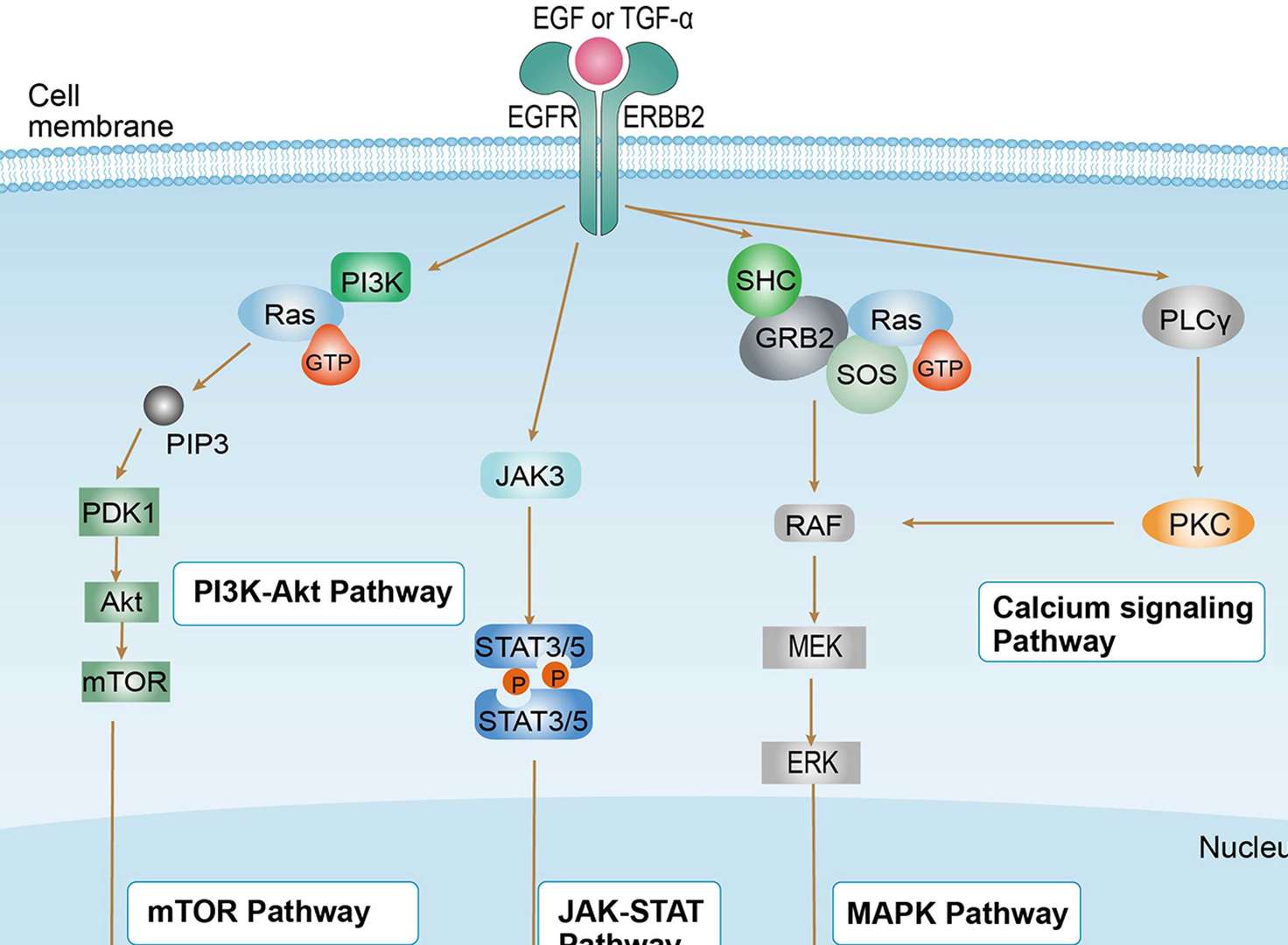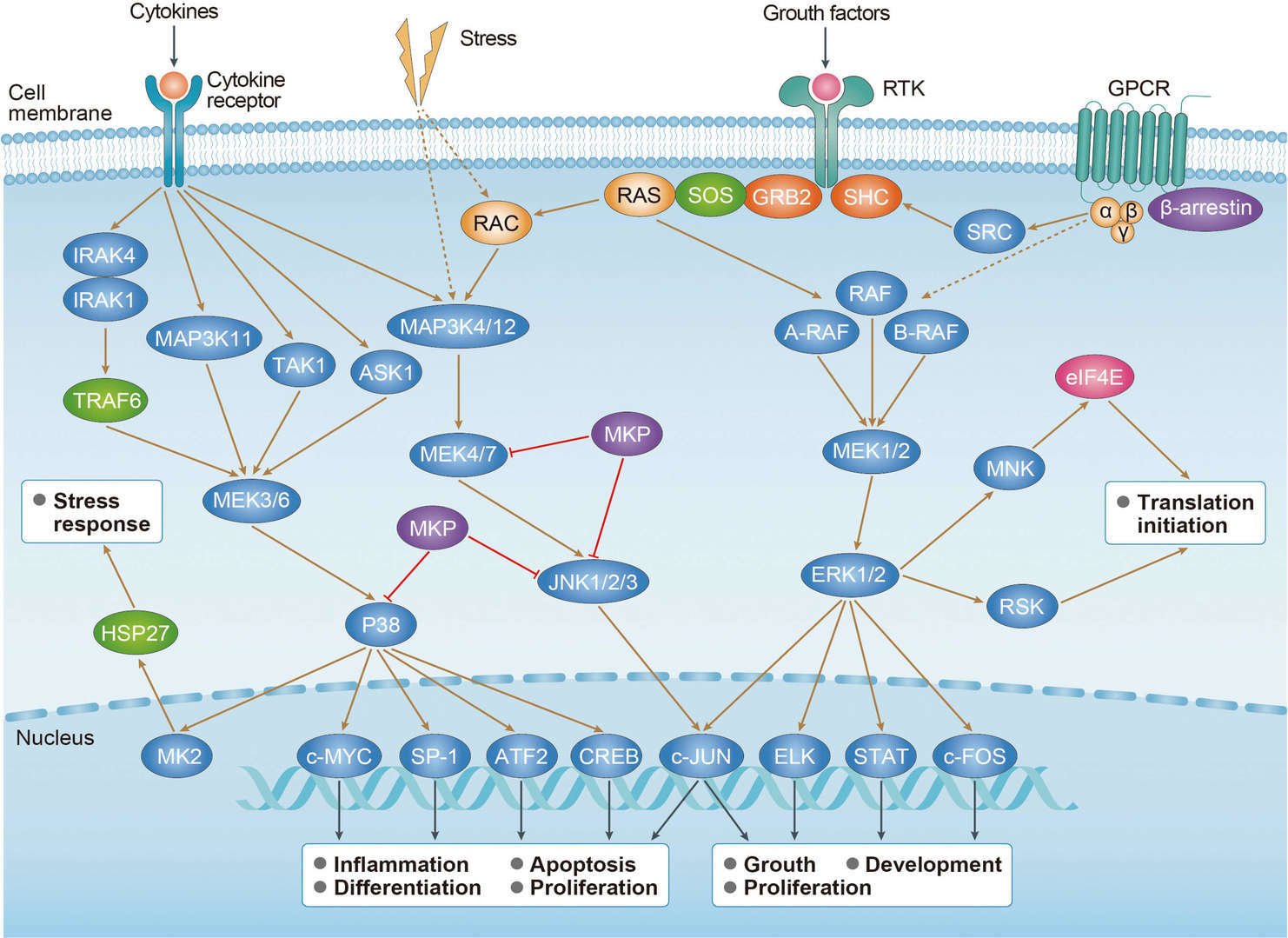RAS Signaling Pathway
About RAS Pathway
Ras, which is a low-molecular-weight GDP/GTP-binding guanine triphosphatase, is the prototypical member of the Ras superfamily of proteins. Ras acts as a binary molecular switch for signal transmission in cells, circulating between the GDP- and GTP-bound states. In normal circumstances, Ras sends signals to the nucleus in the state of GTP-bound. After the signal has been sent, the Ras protein is hydrolyzed into a GDP-bound form and becomes inactive once again. The GTPase, the key in the transformation signal of Ras, is dependent on the opposing effects of two distinct classes of regulatory ras-binding molecules, GAPs (GTPase activating proteins) and GEFs (Guanine nucleotide exchange factors). GAPs can bind to activated G proteins and turn the G protein’s activity off, promoting the formation of the GDP-ras complex. While the GEFs function is opposite to that of GAPs, which serve to catalyze the exchange of GTP for GDP, causing ras activation. There is two best-known GEFs classes: the son of sevenless class (SOS) and the ras-guanine-nucleotide releasing factor (ras-GRF) class. Structural studies show that Ras contains six β chains and five α helices. And it contains two main domains: a G domain that binds guanosine nucleotides, and a C-terminal membrane targeting region (CAAX-COOH, also known as CAAX box). Ras itself has no ability to bind to the membrane due to its low hydrophobicity, thus it must be lipid-modified by farnesyl transferase, RCE1, and ICMT to enhance it hydrophobicity, binding to the cell inner membrane. The G domain of Ras contains five G motifs. The G1 motif binds the β phosphate of GDP and GTP. The G2 motif and G3 motif, also called Switch I and Switch II separately, mediates the basic functionality of the G protein as a molecular switch protein. The G2 motif can bind the terminal phosphate (γ-phosphate) of GTP and the divalent magnesium ion bound in the active site, and the G3 motif is the key residue that activates a catalytic water molecule for hydrolysis of GTP to GDP. The G4 motif contains specific site that interaction to guanine. And the G5 motif provides specificity for guanine as it contains a SAK consensus sequence.
Ras is an important intercellular signal molecular that involved in numerous cellular functions. It receives from a wide range of cell surface receptors and transmits these signals through an ever-increasing list of effector proteins in turn, regulating cell proliferation, survival, differentiation, and apoptosis. The upstream pathway of Ras can be simply summarized as regulated by the circulation of GTP and GDP. But in fact, other molecules such as growth-factor-receptor-bound protein 2 (GRB2), SHC are also involved. The downstream signal of Ras can be summarized as four pathways. The most studied effector is the potien serine/threonine kinase RAF. GTP-bound Ras binds to and dimerizes RAF, thereby, RAF is dimerized and activated. Then, activated RAF phosphorylates and activates mitogen-activated protein kinase kinases 1 and 2 (MEK1 and MEK2), which makes the activated signal transmit into the mitogen-activated protein kinases (MAPKs) extracellular signal-regulated kinases 1 and 2 (ERK1/2). The downstream effectors of ERK1/2 include many cytosolic and nuclear proteins as ELK1-regulate the expression of FOS, c-JUN-regulate the activation of AP1 transcription factor. In addition to RAF/MAPK pathway, Ras can also interact with P110 subunit of type I phosphatidylinositol 3-kinases (PI3Ks), which contains regulatory (p85) and catalytic (p110) subunits. The binding of Ras to PI3Ks phosphorylates phosphatidylinositol-4,5-bisphosphate (PIP2) to phosphatidylinositol-3,4,5-trisphosphate (PIP3), which is a second messenger. The most known downstream eazyme is phosphoinositide-dependent kinase-1 (PDK1), which phosphorylates a serine/threonine kinase, Akt. Activated Akt is further induces the activation of mammalian target of rapamycin (mTOR) complex, which controls the cell growth. Another effector family of Ras comprises three exchange factors for the RAS-related RAL proteins: RAL guanine nucleotide dissociation stimulator (RALGDS), RALGDS-like gene (RGL/RSB2) and RGL2/RLF. Through this pathway, Ras can stimulate RAL and inhibit the FORKHEAD transcription factors of the FoxO family. The last reported effctor of Ras is phospholipase Cε. Studies shows that phospholipase Cε could link RAS to activation of PKC and calcium mobilization.
Overview of RAS Signaling Pathway
Associated Diseases
Related Pathways
For research use only. Not intended for any clinical use.
This site is protected by reCAPTCHA and the Google Privacy Policy and Terms of Service apply.


 Non-small Cell Lung Cancer
Non-small Cell Lung Cancer MAPK Signaling Pathway
MAPK Signaling Pathway mTOR Signaling Pathway
mTOR Signaling Pathway
